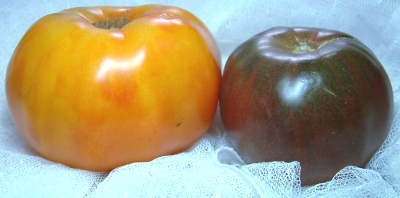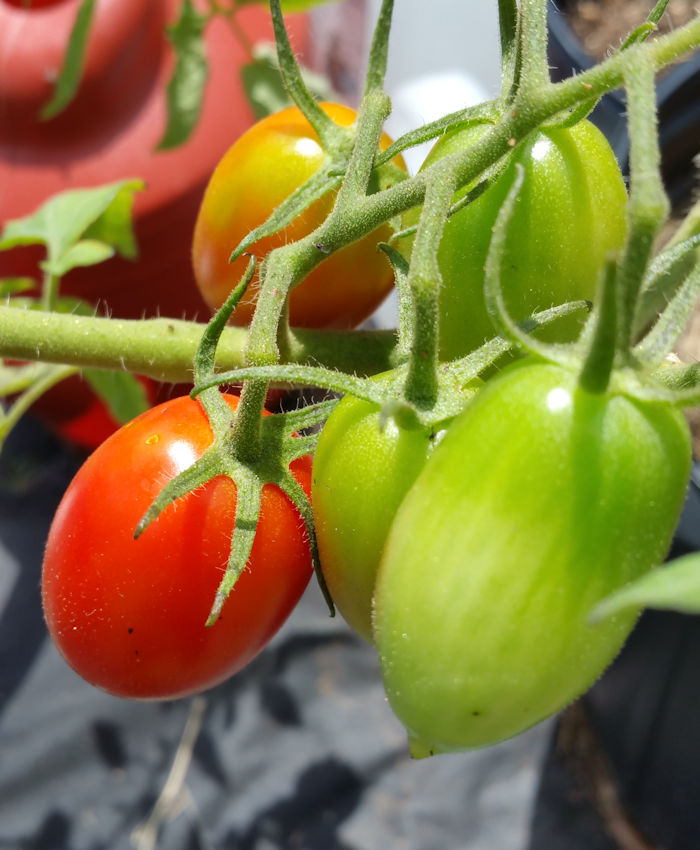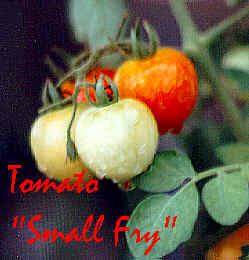Tomato Insects
Tomatoes are pretty “user friendly”, but that doesn’t mean you won’t have to check your plants. A hungry tomato hornworm can decimate a tomato patch if left to itself, and a horde of grasshoppers can, well, plague you!
So what’s a tomato-loving gardener to do? You can fight back! The most common insects and their suggested means of control is listed below. Note: I am listing more organic methods of control — you can also use commercial pesticides, but read the labels carefully if you go that route.
Tomato Insects and Controlling Them
Aphids: These are very small insects, coming in various sizes (1/16 to 1/8 inch in length) and colors (brown, yellow, pink, or black). They harm tomato plants by piercing the stems and sucking the juices out of the plant. Aphids also secrete a sugary fluid known as honeydew, which gums up the plant and serves as a medium for the growth of sooty mold; a fungus. Preferred method of control is to spray the plant with warm, slightly soapy water (make sure to get the underside of the leaves, too!) Backup control is to dust the plants with diatomaceous earth. Repeat the treatment in a week.
Thrips: Thrips are small (about 1/16 inch long) and slender insects. They live in flowers, on tender leaves and leaflets, feeding on the sap. One part of the thrips’ mouth acts like a rasp and tears the surface of the plant, exposing the contents. The fluid is then sucked up through another part of the mouth. The adults range in color from yellow to black, while the immature wingless nymphs are light in color. Their feeding usually causes leaf-curl (leaves curl in an upward fashion) or some type of distortion. Preferred method of control is spray them with warm, slight soapy water. Backup control is to dust the plants with diatomaceous earth.
Spider Mites: Spider mites are about 1/60 of an inch long (in other words, really tiny), and they may be whitish, green or red, depending upon the species. They are eight-legged (the insects have six legs) and are close relatives to spiders rather than insects. Spider mites live on the sap of the plant which is drawn by piercing the leaf with two sharp, slender lances attached to the mouth. Mites spin webs as do spiders, and are able to be blown from field to field by floating or parachuting in the wind. In periods of hot dry weather the leaves of host plants become blotched with pale yellow, reddish-brown spots ranging from small to large areas on both upper and lower leaf surfaces. The leaves become pale and sickly in appearance, gradually die, and drop off the plant (the leaves look as though they have been dusted with some sort of powder, caused by molted skins of the mites). The mites are also pests of plants grown inside or in greenhouses. The preferred method of control is hosing off with cold water, followed by a thorough dusting of diatomaceous earth. A second treatment should be applied from five to seven days following the first, in order to control spider mites. This is because the first application kills the nymphs and adults, but the eggs might still hatch, giving birth to a new generation.
Tomato Hornworm: These fierce-looking critters are able to munch a tomato plant in no time, if left unchecked. You can recognize these caterpillars by the distinctive “horn” (which is actually located on its rear). Preferred method of control is to pluck them off and drown them in soapy water.
Cutworm: These worms are able to “mow down” young seedlings, by munching clear through the stem! The preferred method of control is to place a “collar” around the tomato plant. This can be as simple as taking the tissue roll (or a paper towel roll, cut in half) and carefully placing it over the tomato plant and pushing it an inch or so into the spoil. Tin foil also works.
Leafhoppers: Leafhoppers vary in size from 1/20 to 1/4 inch but a few will reach 1/2 inch in length. Most are wedge-shaped, broad at the head and pointed behind. They are often brilliantly colored, and may have solid, striped, spotted or banded color patterns. However, some are dull colored (brown, tan, gray). When leafhoppers are abundant on any crop, the plants show a lack of vigor, growth is retarded and, in most cases, the leaves have a mottled appearance, or turn yellow, red or brown. This is due to the leafhoppers sucking out the sap. Several species of leafhoppers transmit plant viruses. The adults lay eggs in the plant stem, buds or leaves, which hatch into wingless nymphs (which feed the same way as the adults). Control is usually accomplished by proper spraying of the crop with a recommended insecticide (Safer brand preferred).
Whiteflies: This insect is about 1/32″ long, and is light in color. It inhabits and feeds on the undersurfaces of leaves by penetrating the tissue and removing plant sap with its piercing-sucking mouthparts. Adults congregate, feed, and mate on the undersurfaces of the leaves, and this can occur in such numbers that “clouds” of insects appear, when disturbed. Other forms of damage include the removal of plant sap, vine, leaf, and plant breakdown, yellowing, leaf shedding and abnormalities of fruiting structure. Control is difficult, but try warm soapy water.
Colorado potato beetle: The adult is about 3/8 of an inch long and has alternate black and yellow stripes running lengthwise down the back of its body (five of each color on each wing cover). It lays patches of about one dozen yellowish-orange colored eggs on the underside of the leaves. The smooth skinned larvae are pink to red in color and have two rows of small black spots on their sides. The larvae reach 1/2 inch in length when fully mature and possess well-developed legs. Both the adults and larvae feed by chewing the leaves and terminal growth of the host plant. Preferred method of control is Bt.
Nematodes: The nemesis of Florida gardeners (but found all over) is the nematode. These tiny worms infiltrate the root system, crippling and even killing the plant. The preferred method of control is to plant marigolds the season before planting the tomato plants (marigolds give off a chemical that wards off the nematodes) or at least plant the marigolds along withe the tomatoes. Backup method is to “solarize” the soil for at least a week before planting the tomato plants. (To solarize the soil, till the ground, then cover it with a thick, clear plastic. The sun will “bake” the soil, killing the nematodes. Since you also kill all the “good” bacteria by this method, so be sure to spread some compost over the solarized soil a week or two before planting.)
Tomato Fun Facts
There are a lot of tomato questions, apart from how to actually grow them. This is more of a fun facts page, where you find out what you didn’t know that you didn’t know about tomatoes!
Tomato Fun Facts
Where Did Tomatoes Come From? The tomato is a New World addition to the diet, originating in South America in the Andes region (Chile, Ecuador, Peru). It was Central American Indians who are thought to be the first to domesticate the tomato. Tomatoes were introduced into the European diet by explorers from Mexico, in the 1500’s. Interestingly, the initial tomatoes brought back to Europe appear to have been yellow, or golden, in color — not the red that is so familiar today.
Are Tomatoes Good for You? Fresh tomatoes are loaded with Vitamins A and C. Not to mention it’s pretty much the best natural source for the antioxidant lycopene.
What Colors do Tomatoes Come In? Just about any color! There are black, white, purple, pink, orange, yellow, red, chocolate and bicolor. Blue tomatoes are now on the scene, and there are even tomatoes that stay green when they are fully ripe! And let’s not forget about the striped tomatoes — oh my!
What Shapes Do Tomatoes Come In? You’re familiar with the round and oval tomato shapes. But some others include heart-shaped, long sausage-shaped, pear-shaped and even square-shaped (okay, kind of a rounded square, but squarish nonetheless).
Which is Better – Determinate or Indeterminate? It depends on what you want to do with the tomatoes! For example, if you plan to eat some of the tomatoes fresh, but you want to preserve/can the rest, a determinate plant might be your best bet. Since it sets all its fruit at the same time, it helps streamline the canning process. If, however, you want a few tomatoes this week, a few next week, etc., an indeterminate plant might be your choice. Your ripe tomatoes are spread out over a several week period. But why not have at least one of each type, to provide constant fresh tomatoes for a variety of uses?
 What Sizes do Tomatoes Come In? The most common size the average gardener will grow is roughly 5 to 8 ounces. The tiniest I’ve ever seen were the about the size of an 8-mm bead; a fraction of an ounce. The largest tomatoes that the average gardener will grow is about 2 pounds (now that’s a LOT of tomato sandwiches)!
What Sizes do Tomatoes Come In? The most common size the average gardener will grow is roughly 5 to 8 ounces. The tiniest I’ve ever seen were the about the size of an 8-mm bead; a fraction of an ounce. The largest tomatoes that the average gardener will grow is about 2 pounds (now that’s a LOT of tomato sandwiches)!
Is it True That Tomatoes and Peppers are Related? Sure! Tomatoes and peppers are both part of the Solanaceae family, along with eggplants, tomatillos and potatoes! The tomato’s scientific name is Lycopersicon esculentum, which translates to “edible wolf-peach”. (With a name like that, no wonder the tomato was shunned as a food for many years!)
What’s the Difference Between Heirloom and Open Pollinated Tomatoes? Heirloom tomatoes are those varieties that have been around for at least since 1950, and they breed true from seed. In other words, if you save the seeds from a ripe heirloom tomato, you are likely to get a tomato that’s just like the parent. An open pollinated tomato is very similar; it just hasn’t been around as long as an heirloom. Keep this in mind — all heirlooms are open-pollinated (they breed true to seed) but not all open-pollinated tomatoes are heirloom.
What’s a Hybrid Tomato? A hybrid tomato, on the other hand, does not breed true. Since it is a deliberate cross between two different tomato plants, hybrids can produce seeds that when planted, can become more like the “grandparents” (which may or may not be a good thing!). Many times you will see “F1” after a tomato name; that is a tip-off that the tomato is a hybrid.
Why are Hybrid Seeds and Plants More Expensive? To get the hybrid seeds, suppliers must plant two different kinds of tomatoes and cross them to get the hybrid seeds. In most cases, the parent tomatoes are “trade secrets”. It’s also expensive to hand-pollinate the tomato blossoms, to assure the correct cross is made, or grow them in greenhouses, segregated spaces, etc. All this adds to the price of hybrid seeds.
What Kind is Best? It depends on what you want! In general, although vine-ripened hybrid tomatoes grown at home taste much better than their anemic cousins sold at the grocery store, it’s the heirloom and open-pollinated tomatoes that usually win the taste-tests. In addition, if you want to grow your plants organically (or at least with minimal chemical fertilizers), heirloom tomatoes have the tendency to do better. Here’s the caveat; hybrid tomatoes generally have greater disease-resistance than do heirloom. A compromise is sometimes the open-pollinated, which often have more disease-resistance, yet still have a great taste. (I grow and eat all three kinds, although I tend to grow more heirloom than anything else.) What it boils down to is what is most important to you, and how you plan to use the tomatoes.
How Many Different Kinds of Tomato Varieties are Available? In a word – lots! The Seed Savers Exchange (SSE), located in Decorah, Iowa, lists close to 2,000 tomatoes in its yearbook. However, the SSE catalogs just heirloom and open-pollinated tomatoes; don’t forget that there are still hundreds (if not more) of hybrid varieties. There are estimates that close to 10,000 varieties may exist in the world today.
How Long Will a Tomato Plant Live? Alas, tomato plants live only a season. When the frost comes, the tomato plants die. In mild regions, tomato plants can live a bit longer, but they do eventually die. Consider then annuals.
Where Can I Get Different Kinds of Tomatoes? Why not grow your own? They’re fun to grow, and you can be sure they’re vine-ripened and fresh. Also, growing your own tomatoes allows you to grow the varieties that you like — not what the grocery store buyer thinks you should like. You can buy a plant at a gardening center or better yet — grow your own from seeds. Anyway you can get them, once you’ve eaten homegrown tomatoes, no grocery store tomato will ever measure up.
Tomato Growing Terms To Know
So, you’re taking the tomato growing step — having lush, ripe, flavorful tomatoes for your kitchen (and your tastebuds). Congratulations! You’ll be thrilled when you bite into your first ripe tomato, fresh from the vine. It’s a taste like no other. But before you buy that packet of seeds or run to the garden shop for a plant, know what you’re buying.
Tomato Growing Terms To Know
There are some terms you’ll hear from time to time, and you’ll want to know what they mean. Here are some of the most frequent and need to know terms, to get you on your tomato growing way!
- Determinate: This means that the tomato plant grows to a certain size (dictated by genetics), then produces all of its fruits at once. Great for canning, saucing, or if you just want lots of tomatoes!
- Heirloom/Open-Pollinated: These are tomato plants from yesteryear, whose seeds have been passed down for generations. These tomatos generally have that luscious taste you remember and long for, and many are very easy to grow.
- Hybrid: These tomato plants are generally higher-yielding, more uniform, and have more disease tolerance. These are the “no fuss” tomato plants, but they may somewhat lack the intense tomato taste of the Heirlooms.
- Indeterminate: These are tomato plants that grow a little, set some fruit, grow some more, set some fruit, etc., until the plant dies. Tomatoes are produced over a longer time period than for determinates, but fewer are produced at a time.
- Potato Leaf: This refers to the shape of the tomato plant’s leaves. Potato-leaf plants have leaves shaped like those on a potato plant (hence their name), which are more elongated and smoother than on a “regular” tomato plant.
- Semi-Determinate: There are a few definitions as to what makes a tomato plant a semi-determinate. My definition is a semi-determinate is a plant that grows to almost it’s full height, then sets lots of tomatoes, kind of like a determinate. Then, it slowly grows a bit taller and puts out a few more clutches of tomatoes. So, kind of like half-way between a determinate and an indeterminate.
Grow your own tomatoes and find out what fresh really means!
